Types of Red Beetles (With Pictures) – Identification Guide

Red beetles have a striking appearance due to their vibrant crimson red bodies or wing covers. Types of red beetles include the scarlet lily beetle, red pumpkin beetle, red soldier beetle, and the cocklebur weevil. Other types of red beetles include ladybugs which are flying red beetles in the order Coleoptera. Most types of beetles with red wing covers or bodies are found in grasslands, woodlands, and residential gardens.
What insect is a red beetle? Beetles are six-legged insects in the order Coleoptera. The small red bugs typically have a pair of wings encased in a hard, protective shell. There are thousands of beetle species, some of which look bright red or have vibrant red markings.
Identifying red beetles can be challenging because most of them are tiny creatures, and they scurry away fast. The most recognizable types of red beetles are ladybugs, with the crimson red round wing covers and black bodies.
This article is a guide to identifying the most common types of red beetles. Descriptions of their shapes, size, and habits, along with pictures of the red insects, will help recognize individual species.
How to Identify Red Beetles
The identifying feature of red beetles is their bright red to dark red wing covers (called elytra). Some red beetle species also have a red head, red legs, and red antennae. The most common red beetle—the red soldier beetle, has red and black legs and black segmented antennae.
To identify individual red beetle species, look at their antennae — are they clubbed or segmented? Next, examine the body shape and shade of red. For example, is the beetle slender or elongated, rounded and oval? Lastly, take note of its size. These characteristics help to identify the red beetle.
Types of Red Beetles (With Pictures) – Identification
Red beetles belong to the insect order Coleoptera and are classified into several families. Types of red beetles can include red weevils, scarab beetles, soldier beetles, and red ladybugs. Let’s look in more detail at common varieties of beetles with red bodies you are likely to come across.
Scarlet Lily Beetle (Lilioceris lilii)
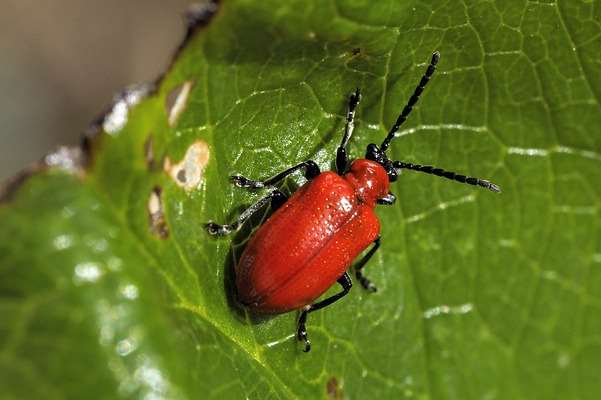
The scarlet lily beetle is a bright red small beetle with black legs and black antennae
The scarlet lily beetle is a small red beetle measuring 0.23” to 0.35” (6 – 9 mm) and recognized by its dimpled red elytra. It’s a tiny red bug with long legs, long black segmented antennae, and a black head. Also called the red lily beetle or lily leaf beetle, the bug is common in gardens.
The bright red scarlet lily beetle has an elongated oval shape and shiny red elytra. However, other parts of the beetle are black, including the undersides of its wings. Looking up close, you’ll notice the red insect has a slim thorax compared to its broad abdomen.
As its name suggests, the scarlet lily beetle is found on plants in the Lilium and Fritillaria genus. The little red pests devour lily leaves, stems, and flower buds. In addition, their yellow or brown larvae can defoliate lily plants, leaving them almost bare.
Scarlet lily beetles are classified in the family Chrysomelidae, a group of leaf-eating beetles. Their red color makes them easy to recognize against green foliage. Although this red beetle has wings, it doesn’t fly, but it crawls on plants.
The shiny red wing covers of the lily leaf beetle make them easy to confuse with another type of red beetle—the cardinal beetle (Pyrochroa serraticornis). The difference between the scarlet lily beetle and the red cardinal beetle is that the scarlet lily beetle has shiny, dimpled wings and 11-segmented antennae.
Red Beetle Identification
Identifying features of the scarlet lily beetle are its shiny red elytra with a dimpled appearance, long black antennae with 11 segments each, and a black head and legs.
Common Cardinal Beetle (Pyrochroa serraticornis)

The common cardinal beetle (Pyrochroa serraticornis) is also called the red-headed cardinal beetle and is completely red except of the black legs and antennae
The common cardinal beetle is a small red beetle measuring 0.8” (20 mm) long and has red elytra, thorax, and head. Red-headed cardinal beetles have spindly black legs and long, toothed, or comb-like antennae. Cardinal beetles usually feed on flying insects on flowers and tree bark.
Compared to the scarlet lily beetle, the cardinal beetle is hard to tell apart. The distinguishing features of the red cardinal beetle are its toothed antennae, dull red, narrow wing cases, and diet—cardinal beetles feed on insects, not plants.
There are three types of cardinal beetles. The common cardinal beetle (Pyrochroa serraticornis) looks completely red apart from its legs and antennae. The rarer black-headed cardinal beetle (Pyrochroa coccinea) looks more like the lily beetle due to its black head. And the tiny red scarce cardinal (Schizotus pectinicornis) is rarely seen in the United States.
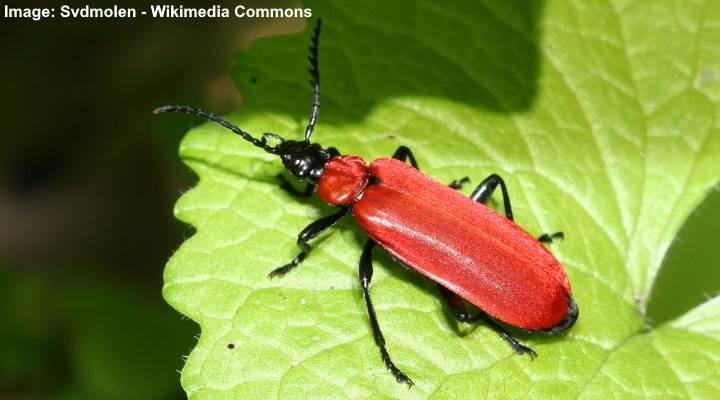
The black headed cardinal beetle (Pyrochroa coccinea) has a red body with black head, legs and antennae
Cardinal beetles belong to the family Pyrochroidae—a group of fire-colored carnivorous beetles that generally live in dead tree bark and rotting tree stumps.
Red Beetle Identification
The common cardinal beetle is identified by its red head, thorax, and elongated wing covers. Additionally, the red beetle has black comb antennae and large black eyes.
Red Pumpkin Beetle (Aulacophora foveicollis)
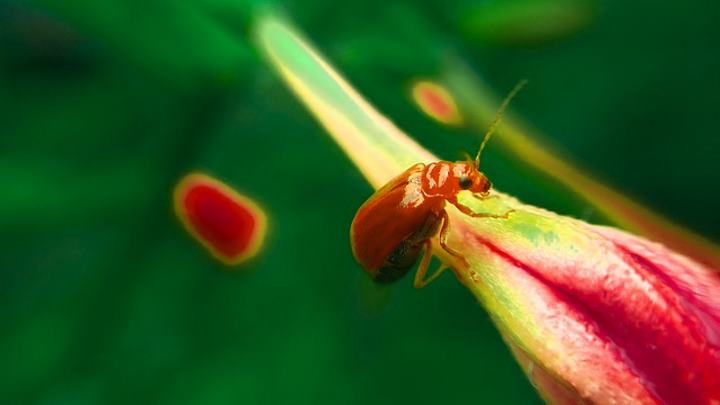
The little red pumpkin beetle has a shiny reddish-orange body with large black eyes and feeds on gourd plants
The red pumpkin beetle is a tiny leaf-eating beetle with a bright orange-red body measuring 0.2” to 0.3” (5 – 8 mm) long. The beetle is described as having shiny reddish-brown oval elytra, head and thorax, black abdomen, and spindly orange antennae. The destructive red bug feeds on plants in the gourd family.
As their name suggests, red pumpkin beetles primarily feed on pumpkin leaves. However, the pesky orangey-red bugs cause plant damage at all stages of their lives. The white grubs live in the soil and feed on roots. The red adult beetles devour plant leaves and can defoliate plants.
Red pumpkin beetles are a member of the insect family Chrysomelidae. These are a type of leaf beetle that cause crop destruction. Other plants in the gourd family where you will find these red pests are watermelon, cucumber, muskmelon, and squash.
Red Beetle Identification
Identifying features of the red pumpkin beetle are its bright-reddish-orange oval elytra, stout thorax, and small reddish head with large black eyes.
Red Milkweed Beetle (Tetraopes tetrophthalmus)
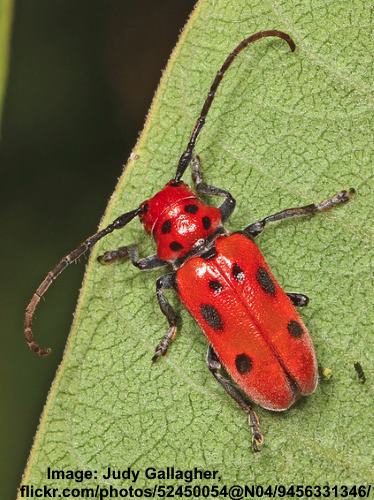
The red milkweed beetle has elongated body with black dots
The red milkweed beetle is a type of red and black bug that measures 0.3” to 0.6” (8 – 15 mm) long and has identifiable ladybug-like markings. The beetles are easy to spot due to their vibrant scarlet-red color and black spots on their wing covers. The herbivore beetles feed on milkweed plants.
Red milkweed beetles belong to the insect family Cerambycidae, or longhorn beetles. As the name suggests, the identifying characteristic of the red and black longhorn beetle is its long, arching, segmented black antennae. With red milkweed beetles, the black antennae are close to the eyes—a unique feature of these beetles.
The common name, red milkweed beetle, implies that these beetles feed on milkweed plants (Asclepias). The beetle’s diet gives it a measure of protection due to the toxins contained in milkweed sap. This makes the red milkweed beetle a poisonous beetle to predators that avoid the beetle due to its rancid taste.
The bright red colors of the milkweed beetle also act as a warning to insects that may be tempted to eat it.
An unusual feature of red milkweed beetles is the shrill noise they make when startled and a purring noise when interacting with other beetles.
Red Beetle Identification
The spotted red milkweed beetle is easily identified by its bright red wing covers, thorax, and head with tiny black dots. However, this makes the beetles easy to confuse with red flying beetles—ladybugs.
Red Ladybugs (Coccinellidae) — Red Flying Beetles
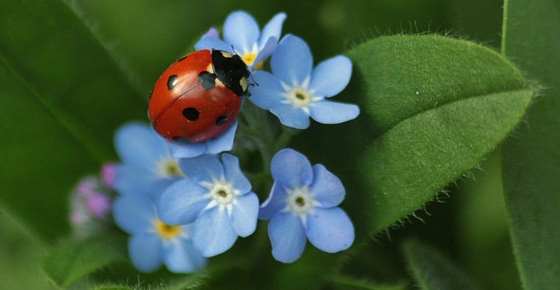
The seven-spotted ladybird (Coccinella septempunctata) is common in Europe and has been successfully introduced into states in the US
Most species of ladybugs are small, rounded red-colored beetles with bright red, black-spotted wing covers, measuring between 0.03” and 0.7” (0.8 – 18 mm). Ladybugs are easily identifiable with their red color, black spots, and black head. Typically, red ladybug beetles have dome-shaped bodies and six short black legs.
Ladybugs are also called ladybird beetles or lady beetles. The spotted red insects are a species of flying beetle considered to be beneficial insects. Many ladybug species feed on aphids and scale insects. However, invasive species of ladybugs can damage crops and be a significant pest.
Although many ladybug species are red with black dots, some ladybugs are black with red spots or yellow with black spots. Some of these flying beetles also have striped elytra.
Red Beetle Identification
Ladybugs are easy to identify with their domed red wing covers and black spots.
Cocklebur Weevil (Rhodobaenus quinquepunctatus)
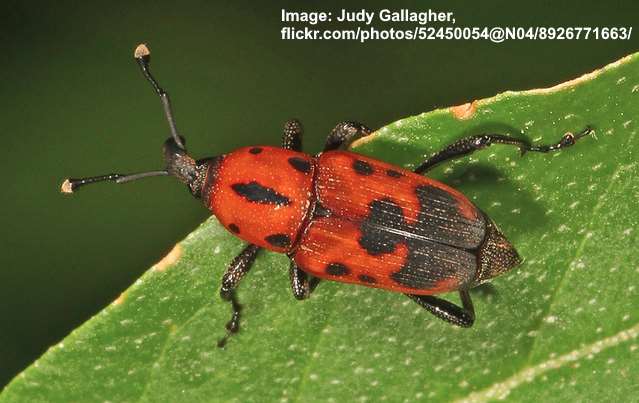
The tiny cocklebur weevil has a small black head with long snout and black patterns on its red body
The cocklebur weevil is a slender red beetle with identifiable black spots on its thorax and wing covers. The tiny black and red beetles measure 0.19” to 0.25” (5 – 6 mm). Like all weevils, this red beetle has a characteristic long, oval-shaped snout. In addition, the red bug has black legs and two clubbed antennae.
Although the coloring pattern is similar, it’s easy to tell cocklebur weevils apart from ladybugs and red milkweed beetles. For example, cocklebur weevils have a slender, not rounded body like ladybugs. Also, the black snout and clubbed antennae help differentiate them from milkweed beetles.
A large infestation of red and black cocklebur weevils can do tremendous plant damage in gardens. The destructive pests feed on ragweed, sunflowers, and cocklebur plants. However, they are hard to spot in gardens as they prefer to hide in curled leaves and under flowers.
Red Beetle Identification
You can identify cocklebur weevils by the black spots on a bright red, elongated slender body, and long curling snout they use for feeding.
Red Net-Winged Beetle (Dictyoptera aurora)
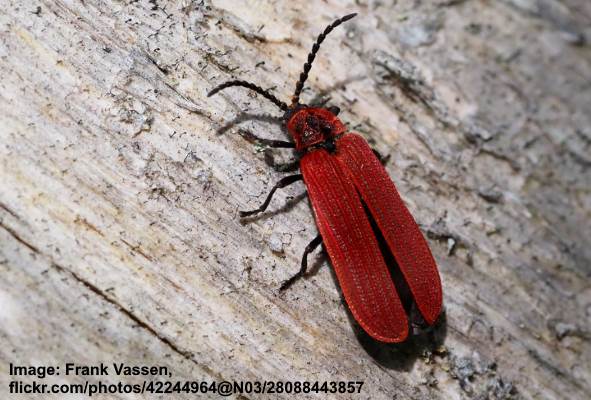
The red net-winged beetle has a slender dark red body with ridges and black head and antennae
The red net-winged beetle is a dark red beetle that measures 0.23” to 0.43” (6 – 11 mm) long. The red bug has a square-shaped thorax, black head, and segmented antennae. The unusual ridges running lengthwise along the wing covers identify the dark red slender beetle.
Red net-winged beetles belong to the beetle family Lycidae. These flying red beetles are recognized by their long, ribbed elytra and unusually shaped square to triangular heads. The scientific name of the beetle Aurora refers to its brilliant red color, like the Roman goddess of dawn.
Red net-winged beetles usually feed on small insects, pollen, and nectar. You will often find the adult beetles living in decaying wood, where their white larvae also live. This beetle doesn’t sting or bite and isn’t a garden nuisance.
Red Beetle Identification
Identifying features of the red-net winged beetle are its vibrantly colored red wing covers, segmented black antennae, narrow body, and ability to fly.
Ninebark Calligraphy Beetle (Calligrapha spiraea)

The beautiful ninebark calligraphy beetle has a bright red rounded body with black markings
The ninebark calligraphy beetle is a stunning bright red beetle with curved black markings and a black line down its center. This red and black beetle has a rounded, oval body, a black thorax and head, and orangey-red segmented antennae. Unlike other red beetle varieties, this species has red legs, not black ones.
The small shiny red beetle measures 0.23” to 0.27” (6 – 7 mm) long. Its common and scientific names come from the scrawly black markings on the crimson red wing covers. This species of leaf beetle feeds on ninebark shrubs.
The red calligraphy beetle has a similar shape to ladybugs. However, its attractive black markings help to differentiate it.
Many types of calligraphy beetles appear similar. But, you can usually tell the individual species apart by the kind of plant you find it on.
Red Beetle Identification
The red ninebark calligraphy beetle is identified by its glossy bright red elytra covered with curling black marks and spots.
Common Red Soldier Beetle (Rhagonycha fulva)
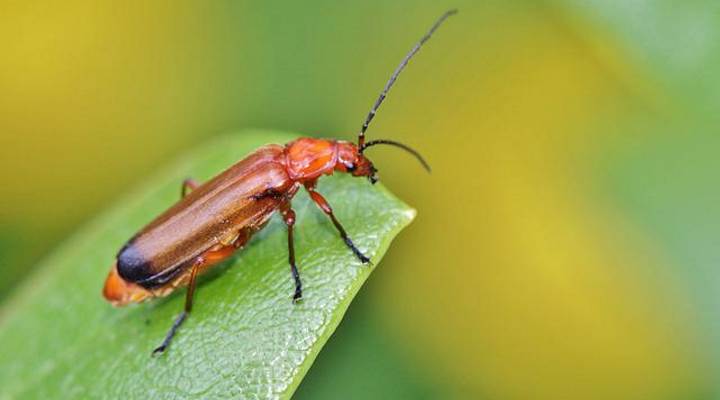
The common red soldier beetle is identified by its orange-red body with black patch at the rear
The common red soldier beetle is a shiny slender reddish-orange beetle that measures 0.3” to 0.4” (8 – 10 mm). The beetle’s identifying features are its glossy orange-red head, black segmented antennae, and fine hairs on its head. This red bug feeds on aphids, nectar, and pollen.
The reddish color of the beetle gives its other common name—bloodsucker beetle. However, this name is misleading because the orange-red insect doesn’t bite humans, and it is harmless. Pictures of the beetle show its dark red elytra has a visible black patch at the tail end.
The common red soldier beetle is classified in the insect family Cantharidae. This beetle group is called soldier beetles, and they have characteristic soft bodies. In some languages, the beetle’s common name means “soft red beetle.”
The glossy red beetle is typically found in gardens, hedgerows, grasslands, and woodlands. The red-winged insect feeds on daisies, asters, sunflowers, and hogweed. Additionally, it’s an important pollinator.
Red Beetle Identification
To identify the common red soldier beetle, look for its orange-red color, segmented antennae with small orange patches, and orange and black legs.
Desert Blister Beetle (Lytta magister)
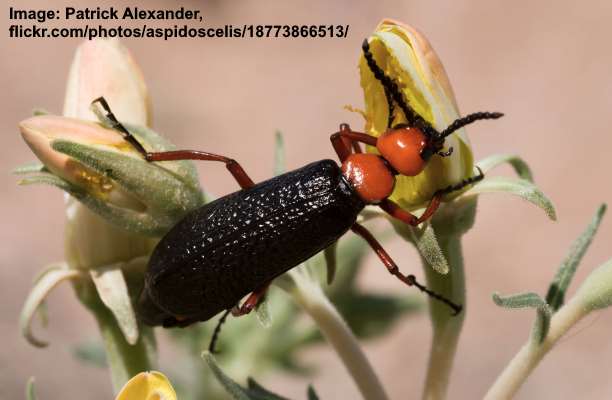
The desert blister beetle has reddish-orange head and black oval long body
The desert blister beetle is a large red and black beetle measuring between 0.6” and 1.3” (16 – 33 mm). The characteristic features of the heat-loving beetle are a dark orange or red head and thorax, jet-black elongated body, and orange and black legs. The large desert beetle also has segmented black antennae.
The flying red and black beetle usually swarms in desert environments in southwestern North America. The predatory insects feed on brittlebush flowers and leaves. The larvae are insectivorous and attack bee nests.
The beetle is classified as a blister beetle in the family Meloidae. Its name comes from the toxic, blister-causing secretion it emits when under threat. Although not classed as a poisonous beetle, it can bite when it feels threatened.
Red Beetle Identification
The desert blister beetle is identified by its bright reddish-orange head, thorax, legs, and shiny black abdomen.
Related articles:
